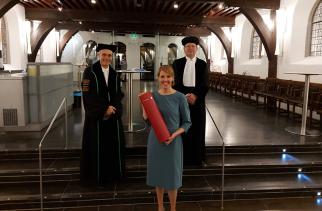Senior onderzoeker Farmaceutische Zorg
Publicatie
Publicatie datum
To what extent does sociodemographic composition of the neighbourhood explain regional differences in demand of primary out-of-hours care: a multilevel study.
Jansen, T., Zwaanswijk, M., Hek, K., Bakker, D. de. To what extent does sociodemographic composition of the neighbourhood explain regional differences in demand of primary out-of-hours care: a multilevel study. BMC Family Practice: 2015, 16(54)
Lees online
Background
In the Netherlands, primary out-of-hours (OOH) care is provided by large scale General Practitioner (GP) cooperatives. GP cooperatives can be contacted by patients living in the area surrounding the GP cooperative (catchment area) at hours when the patient’s own general practice is closed. The frequency of primary OOH care use substantially differs between GP cooperative catchment areas. To enable a better match between supply and demand of OOH services, understanding of the factors associated with primary OOH care use is essential. The present study evaluated the contribution of sociodemographic composition of the neighbourhood in explaining differences in primary OOH care use between GP cooperative catchment areas.
Methods
Data about patients’ contacts with primary OOH services (n = 1,668,047) were derived from routine electronic health records of 21 GP cooperatives participating in the NIVEL Primary Care Database in 2012. The study sample is representative for the Dutch population (for age and gender). Data were matched with sociodemographic characteristics (e.g. gender, age, low-income status, degree of urbanisation) on postcode level. Multilevel linear regression models included postcode level (first level), nested within GP cooperative catchment areas (second level). We investigated whether contacts in primary OOH care were associated with neighbourhood sociodemographic characteristics.
Results
The demand of primary OOH care was significantly higher in neighbourhoods with more women, low-income households, non-Western immigrants, neighbourhoods with a higher degree of urbanisation, and low neighbourhood socioeconomic status. Conversely, lower demand was associated with neighbourhoods with more 5 to 24 year old inhabitants. Sociodemographic neighbourhood characteristics explained a large part of the variation between GP cooperatives (R-squared ranging from 8% to 52%). Nevertheless, the multilevel models also showed that a considerable amount of variation in demand between GP cooperatives remained unexplained by sociodemographic characteristics, particularly regarding high-urgency contacts.
Conclusions
Although part of the variation between GP cooperatives could not be attributed to neighbourhood characteristics, the sociodemographic composition of the neighbourhood is a fair predictor of the demand of primary OOH care. Accordingly, this study provides a useful starting point for an improved planning of the supply of primary OOH care. (aut. ref.)
In the Netherlands, primary out-of-hours (OOH) care is provided by large scale General Practitioner (GP) cooperatives. GP cooperatives can be contacted by patients living in the area surrounding the GP cooperative (catchment area) at hours when the patient’s own general practice is closed. The frequency of primary OOH care use substantially differs between GP cooperative catchment areas. To enable a better match between supply and demand of OOH services, understanding of the factors associated with primary OOH care use is essential. The present study evaluated the contribution of sociodemographic composition of the neighbourhood in explaining differences in primary OOH care use between GP cooperative catchment areas.
Methods
Data about patients’ contacts with primary OOH services (n = 1,668,047) were derived from routine electronic health records of 21 GP cooperatives participating in the NIVEL Primary Care Database in 2012. The study sample is representative for the Dutch population (for age and gender). Data were matched with sociodemographic characteristics (e.g. gender, age, low-income status, degree of urbanisation) on postcode level. Multilevel linear regression models included postcode level (first level), nested within GP cooperative catchment areas (second level). We investigated whether contacts in primary OOH care were associated with neighbourhood sociodemographic characteristics.
Results
The demand of primary OOH care was significantly higher in neighbourhoods with more women, low-income households, non-Western immigrants, neighbourhoods with a higher degree of urbanisation, and low neighbourhood socioeconomic status. Conversely, lower demand was associated with neighbourhoods with more 5 to 24 year old inhabitants. Sociodemographic neighbourhood characteristics explained a large part of the variation between GP cooperatives (R-squared ranging from 8% to 52%). Nevertheless, the multilevel models also showed that a considerable amount of variation in demand between GP cooperatives remained unexplained by sociodemographic characteristics, particularly regarding high-urgency contacts.
Conclusions
Although part of the variation between GP cooperatives could not be attributed to neighbourhood characteristics, the sociodemographic composition of the neighbourhood is a fair predictor of the demand of primary OOH care. Accordingly, this study provides a useful starting point for an improved planning of the supply of primary OOH care. (aut. ref.)
Background
In the Netherlands, primary out-of-hours (OOH) care is provided by large scale General Practitioner (GP) cooperatives. GP cooperatives can be contacted by patients living in the area surrounding the GP cooperative (catchment area) at hours when the patient’s own general practice is closed. The frequency of primary OOH care use substantially differs between GP cooperative catchment areas. To enable a better match between supply and demand of OOH services, understanding of the factors associated with primary OOH care use is essential. The present study evaluated the contribution of sociodemographic composition of the neighbourhood in explaining differences in primary OOH care use between GP cooperative catchment areas.
Methods
Data about patients’ contacts with primary OOH services (n = 1,668,047) were derived from routine electronic health records of 21 GP cooperatives participating in the NIVEL Primary Care Database in 2012. The study sample is representative for the Dutch population (for age and gender). Data were matched with sociodemographic characteristics (e.g. gender, age, low-income status, degree of urbanisation) on postcode level. Multilevel linear regression models included postcode level (first level), nested within GP cooperative catchment areas (second level). We investigated whether contacts in primary OOH care were associated with neighbourhood sociodemographic characteristics.
Results
The demand of primary OOH care was significantly higher in neighbourhoods with more women, low-income households, non-Western immigrants, neighbourhoods with a higher degree of urbanisation, and low neighbourhood socioeconomic status. Conversely, lower demand was associated with neighbourhoods with more 5 to 24 year old inhabitants. Sociodemographic neighbourhood characteristics explained a large part of the variation between GP cooperatives (R-squared ranging from 8% to 52%). Nevertheless, the multilevel models also showed that a considerable amount of variation in demand between GP cooperatives remained unexplained by sociodemographic characteristics, particularly regarding high-urgency contacts.
Conclusions
Although part of the variation between GP cooperatives could not be attributed to neighbourhood characteristics, the sociodemographic composition of the neighbourhood is a fair predictor of the demand of primary OOH care. Accordingly, this study provides a useful starting point for an improved planning of the supply of primary OOH care. (aut. ref.)
In the Netherlands, primary out-of-hours (OOH) care is provided by large scale General Practitioner (GP) cooperatives. GP cooperatives can be contacted by patients living in the area surrounding the GP cooperative (catchment area) at hours when the patient’s own general practice is closed. The frequency of primary OOH care use substantially differs between GP cooperative catchment areas. To enable a better match between supply and demand of OOH services, understanding of the factors associated with primary OOH care use is essential. The present study evaluated the contribution of sociodemographic composition of the neighbourhood in explaining differences in primary OOH care use between GP cooperative catchment areas.
Methods
Data about patients’ contacts with primary OOH services (n = 1,668,047) were derived from routine electronic health records of 21 GP cooperatives participating in the NIVEL Primary Care Database in 2012. The study sample is representative for the Dutch population (for age and gender). Data were matched with sociodemographic characteristics (e.g. gender, age, low-income status, degree of urbanisation) on postcode level. Multilevel linear regression models included postcode level (first level), nested within GP cooperative catchment areas (second level). We investigated whether contacts in primary OOH care were associated with neighbourhood sociodemographic characteristics.
Results
The demand of primary OOH care was significantly higher in neighbourhoods with more women, low-income households, non-Western immigrants, neighbourhoods with a higher degree of urbanisation, and low neighbourhood socioeconomic status. Conversely, lower demand was associated with neighbourhoods with more 5 to 24 year old inhabitants. Sociodemographic neighbourhood characteristics explained a large part of the variation between GP cooperatives (R-squared ranging from 8% to 52%). Nevertheless, the multilevel models also showed that a considerable amount of variation in demand between GP cooperatives remained unexplained by sociodemographic characteristics, particularly regarding high-urgency contacts.
Conclusions
Although part of the variation between GP cooperatives could not be attributed to neighbourhood characteristics, the sociodemographic composition of the neighbourhood is a fair predictor of the demand of primary OOH care. Accordingly, this study provides a useful starting point for an improved planning of the supply of primary OOH care. (aut. ref.)
Gegevensverzameling


